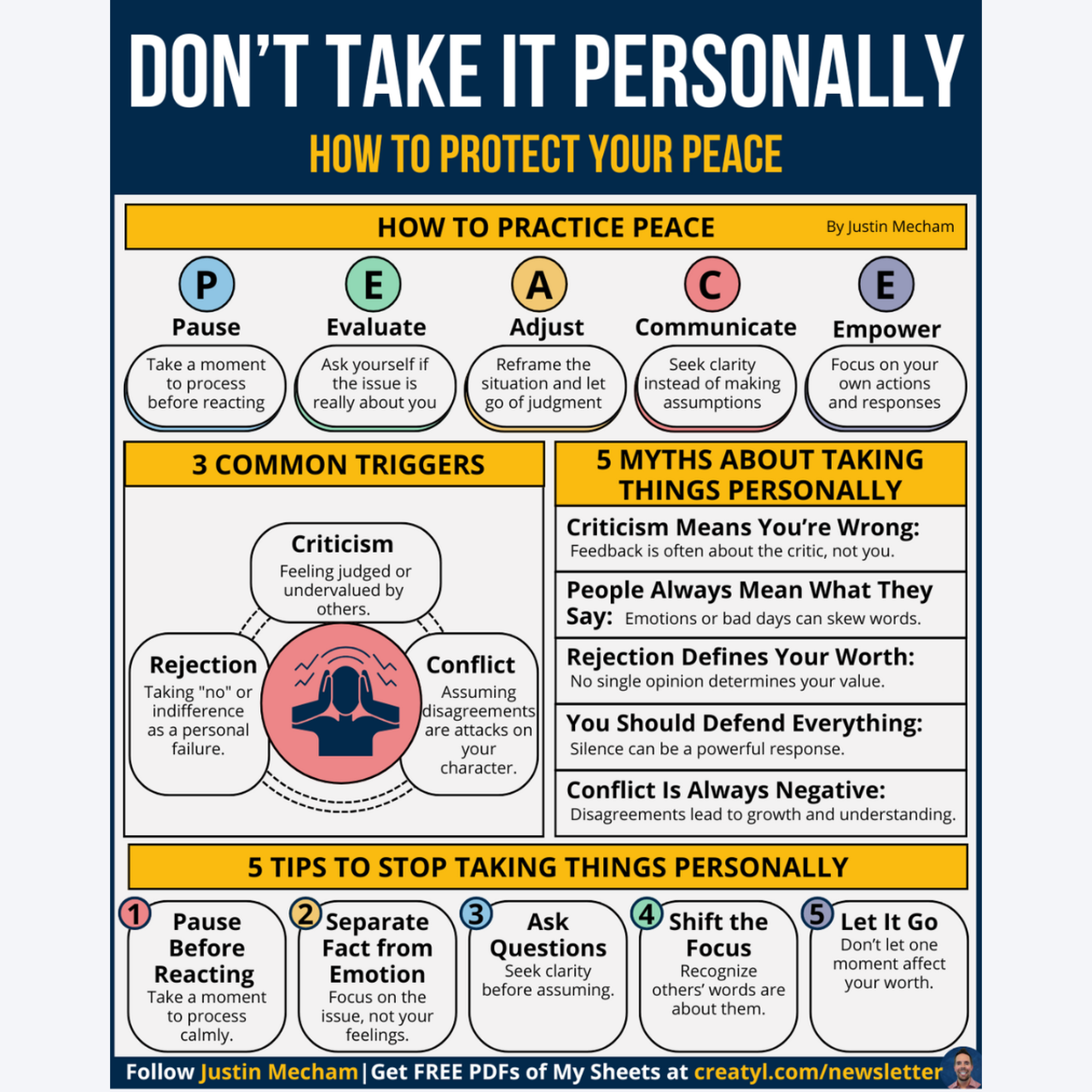Click Here to Download Today's PDF
We’ve all been there.
Someone criticizes your work.
Someone rejects your idea.
Someone disagrees with your plan.
And before you’ve even had a chance to breathe, your brain whispers, This is about you.
But here’s the truth: most of the time, it’s not.
It’s about their pressure. Their story. Their fears.
Not your worth.
If you can learn to tell the difference, you’ll protect something far more valuable than your reputation—you’ll protect your peace.
Why We Take Things So Personally
When we feel judged, dismissed, or opposed, our brains do exactly what they’ve been wired to do for survival:
- We personalize—we make the event about who we are, not just what happened.
- We assign intent—we assume the other person meant to hurt or diminish us.
- We replay the moment—we overthink it, trying to find clues in tone or body language.
It’s called the fundamental attribution error—our tendency to blame a person’s character instead of considering their circumstances.
Add in negativity bias (our brain’s habit of holding on to negative experiences longer than positive ones), and it’s no wonder a single comment can
hijack our day.
The problem isn’t that we care. It’s that we carry far more than we need to.
The Three Triggers That Spark Overthinking
When you find yourself spiraling, it usually traces back to one of three triggers:
- Conflict – assuming that disagreement means something is broken or that it’s a personal attack.
- Criticism – interpreting feedback as a verdict on your ability or character.
- Rejection – believing that a “no” means you’re not good enough.
If you can spot which trigger is at play, you can respond more intentionally—before your brain writes a story you’ll regret believing.
The Myths That Turn Pain Into Identity
Too often, we hold on to false rules that make criticism, rejection, and conflict feel heavier than they need to.
Here are five of the biggest myths worth breaking:
- Criticism means you’re wrong. In reality, feedback often reflects the critic’s priorities, preferences, or stress—not an objective truth about you.
- Every word is truth. People speak through the filter of their own emotions and experiences; their words are not always a clear picture of reality.
- You must explain yourself. Silence can be a powerful choice, especially when an explanation won’t change the outcome.
- Conflict means something’s broken. Disagreement can be the fastest path to better understanding.
- Rejection defines your worth. A “no” is often about fit, timing, or resources—not your value as a person or professional.
The P.E.A.C.E. Method—Upgraded for Real Life
The P.E.A.C.E. method is simple on paper: Pause, Evaluate, Adjust, Communicate, Empower.
But for it to work when emotions run high, you need tactical ways to put each step into action.
1. Pause
Install an if-then rule: If I feel triggered, then I will wait 20 minutes before replying.
That short gap allows adrenaline to settle so you can respond, not react.
2. Evaluate
Run the “Not-About-Me” test:
- What pressure might they be under?
- Could this be about timing, workload, or priorities?
- Is there one useful point I can take from this?
3. Adjust
Reframe the story.
From “This is a verdict on me” to “This is one perspective in a bigger picture.”
From “We’re on opposite sides” to “We want the same outcome, just with different ideas.”
4. Communicate
When clarity is needed, use the four-line script:
- Observation: “When the deadline was moved…”
- Feeling: “…I felt stressed.”
- Need: “…I need clear timing to plan well.”
- Request: “Can we confirm the due date now?”
5. Empower
Set boundaries for your attention. Mute noisy channels. Limit the mental space you give to someone else’s mood or words. Direct your energy toward what’s truly yours to own.
When Feedback Feels Like a Fight
A product team I consulted for was on the verge of burnout.
Every time the senior lead sent feedback in the team chat, it sparked defensiveness.
Comments were read as attacks. People stopped sharing ideas in meetings.
Work slowed—not because of skill gaps, but because of emotional friction.
The cycle looked like this:
Criticism → Personal offense → Defensive response or silence → Delayed progress.
I introduced three changes based on these principles:
1. A 60-second reset before replying
We practiced labeling the emotion (“This is frustration”), zooming out (“Okay, what matters here?”), and reframing (“Maybe they’re stressed about the launch”). Only after this would they decide their next move.
2. Two simple if-then rules
- If a message feels harsh, wait 20 minutes and ask, “What’s the real ask?”
- If someone says “No,” ask, “Is this about timing, budget, or fit?”
3. The four-line clarity script
Instead of pushing back defensively, they focused on facts, needs, and clear asks.
Within two weeks, tension dropped.
The lead kept giving strong feedback—but the team stopped taking it as a personal verdict.
Work picked up speed, and meetings became about solutions instead of tone.
Habits That Protect Peace Daily
- Carry a “Do Not Carry” list. Write down the three things you refuse to mentally carry into tomorrow (e.g., late replies, vague comments, someone else’s mood).
- Use third-person self-talk. “Jordan, you can take a breath. Ask one question.” It’s proven to reduce emotional reactivity.
- Write a 30-word feeling label before replying. It slows you down enough to separate feelings from facts.
These small moves keep you from reacting on impulse and help you choose the story you want to live with.
Recommended Tools for Protecting Your Peace
- Book: The Four Agreements by Don Miguel Ruiz — A modern classic on self-mastery, with one core lesson being “Don’t take anything personally.”
- TED Talk: The Power of Vulnerability by Brené Brown — One of the most-viewed TED Talks ever, offering profound insight into handling shame, criticism, and feedback.
- Tool: Headspace (by Andy Puddicombe & Rich Pierson) — Mindfulness and meditation to reduce reactivity and increase mental clarity.
- Movie: Inside Out 2 (Directed by Kelsey Mann) — The highest-grossing animated film of all time, helping audiences understand emotions in a simple, powerful way.
The Perspective That Changes Everything
Most of the time, what people say tells you more about them than it does about you.
Their words are shaped by their stress, their day, their fears—none of which can measure your value.
The first meaning your mind jumps to is rarely the most accurate.
That first draft of the story is written in adrenaline and assumption.
Give it a second read, when the emotion has cooled, and you’ll see details you missed before.
Even a short pause changes everything.
Twenty minutes can shift you from reacting to responding.
In that space, you can decide if the comment deserves your energy or if it’s just passing noise.
Your job isn’t to carry every piece of feedback to heart—it’s to take what’s useful and let the rest go.
Keep the signal, leave the sting, and then decide on the smallest next step that moves you forward.
Peace doesn’t come from controlling the world. It comes from choosing which meaning you keep and which meaning you leave behind.
Download the Infographic
If you’d like a visual summary of these principles to keep at your desk or share with your team, you can download the infographic from this article as a free PDF.




